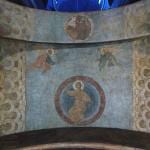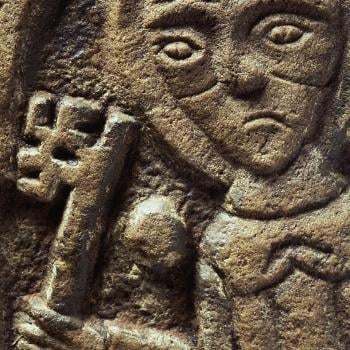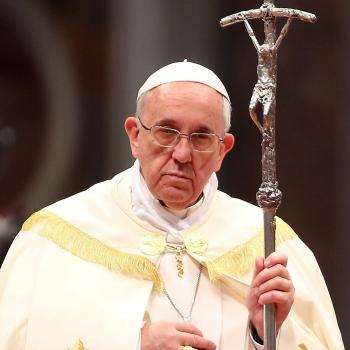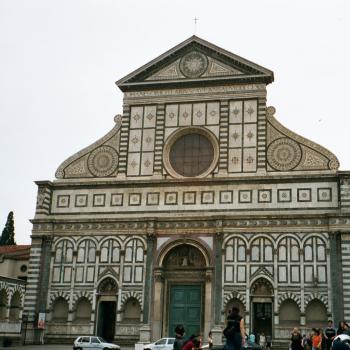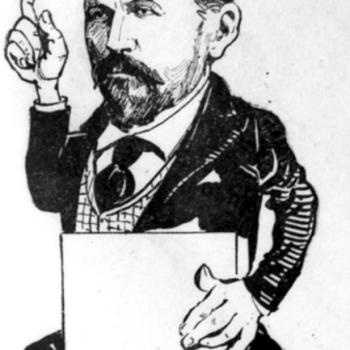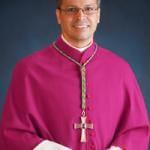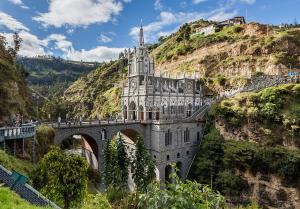
Lumen Gentium presented one of the most important statements of the Church offered at an ecumenical council:
This is the one Church of Christ which in the Creed is professed as one, holy, catholic and apostolic, which our Saviour, after His Resurrection, commissioned Peter to shepherd, and him and the other apostles to extend and direct with authority, which He erected for all ages as “the pillar and mainstay of the truth”. This Church constituted and organized in the world as a society, subsists in the Catholic Church, which is governed by the successor of Peter and by the Bishops in communion with him, although many elements of sanctification and of truth are found outside of its visible structure. These elements, as gifts belonging to the Church of Christ, are forces impelling toward catholic unity.[1]
Much has been written concerning what Lumen Gentium means by saying that the one Church of the creeds subsists in the Catholic Church. Important to us here is that Lumen Gentium talks about elements of sanctification and truth being found outside the visible structure of the Catholic Church. They are gifts which tie those who have them to the Church, and wherever those gifts are found, the various people and groups find themselves united in their participation in the Church. All the gifts, the full sacramental reality, is found in the Catholic Church; insofar as others share in those gifts, they find themselves drawn into the Church and so into a relationship with the Catholic Church. Likewise, the Catholic Church, seeing others with those gifts, seeing others sharing with it elements of the Church, finds itself drawn towards them. It knows, moreover, it has a relationship with them and in with many of them, in some way or another, they already have some level of unity with the Catholic Church (however weak that unity might be). For example, wherever an authentic baptism takes place, the one who is baptized finds themselves joined to Christ, and so find themselves in the body of Christ, the Church. And in doing so, they find themselves mysteriously connected to the Catholic Church, for all that is within the Church is found within the Catholic Church.
The distinction between the Church and how the Church subsists in the Catholic Church in time has been realized in various theologoumena. The distinction between the Church suffering, militant, and triumphant is one of many ways this has been represented in ecclesiology. The Apocalyptic presentation of the Church as existing since the foundation of the world, likewise, only makes sense if we do not confuse the historical, institutional Catholic Church with the fullness of the Church itself. For it is clear, the Catholic Church begun in time (with its institution by Christ).
There is, therefore, an eschatological sign which is involved. The eschaton has been realized in Christ, for in him, the eschaton has been immanentized. In baptism, we find ourselves turned towards the eschaton. We discern that the end truly has come and we participate in it. But we are also a part of history. The end has come into history and we now must realize that end in history itself. Our lives are sacramental signs revealing the eschaton in history. The Catholic Church is itself a sacramental sign of the eschaton in history, bearing with it the fullness of the Church on earth. The Catholic Church, with all its imperfections, with all its failures, with all its history, still presents the sign of Christ and remains the sacrament of salvation to the world. Others share in and participate in that life, and insofar as they do, they are “already and not yet one” with the Catholic Church. In the eschaton, the unity will become fully realized, and all that participated and shared an imperfect unity on earth will find themselves brought together as one. The ecumenical movement must be understood as an eschatological sign as it seeks to realize Jesus’ desire for Christians to be one. It helps reveal the unity which connects Christians despite their historical, theological, and institutional differences.
Sergius Bulgakov, writing on the Church, also followed a similar distinction as found in Lumen Gentium, pointing out the historical, institutional experience of the Church is permeated by the Church itself:
Therefore, the Church as a society, an institution, an organization, the “visible” or empirical Church, does not wholly coincide with the Church as Divine-humanity, with its noumenal depth, although the empirical is connected with, based on, and permeated by the Church as Divine-humanity. [2]
Each community which participates in the Church finds themselves tied together through that participation, giving them a relationship with each other which goes beyond the visible structures of the various communities themselves:
The Church therefore has a symbolic being in the world, as the divine in the human, the invisible in the visible, as Divine-humanity. But in this very same sense the Church and churches, in their interrelationship, represent the one, common sacrament of all the sacraments, the all-sacrament, which contains the mystery of the Church. [3]
Thus, though the Church is centralized in history through the institutional Church, the institutional Church must not be seen as the absolute manifestation of the Church:
The most important truth that follows from this fact is that the hierarchical-sacramental organization is not the adequate or absolute manifestation of the Church, that this organization therefore has a certain relative character. [4]
This is not to say the institutional Church is unimportant; it is very important, because the Church is to have a visible sign of itself in the world. The visible Church, the one which has a history starting with the Apostles and continuing throughout time until history itself is turned over to the eschaton, the Catholic Church, grounds the Church in history. The Catholic Church is the normative means by which the Church can spread itself throughout the world and share its sacramental gifts to all.
The Church subsists in the Catholic Church, showing us that Christianity does not Gnostically reject the world in history. By saying it subsists in the Catholic Church, this makes sure we realize the Church is not limited to its historical manifestation, that people do not, and should not, confuse the historical failures of the institutional Church with the eschatological realization established by Christ. It also means that the Catholic Church does not have to believe itself to be limited to particular disciplines and cultural expressions, but rather, to be open to and inclusive of a variety of traditions within itself, consistently realizing the eschaton in history with the changing needs of the times.
This should help us understand the value of inculturation and why the Catholic Church, the sign of Christ in the world, must find itself engaging and bringing the various expressions of humanity into itself. The Church is the sacrament of sacraments which attests to the incarnation, to the fullness of humanity being incorporated into and accepted by Christ:
The Church is the mystery of the world, which is manifested as sacraments. Therefore, sacrament can be most generally defined as the manifested action of the Church in man. Man is the temple, the sanctuary, the priest, the bringer of sacrifice, and the receiver of sacrifice. The Church herself, the sacrament of sacraments, is not a particular institution, as each of the specific sacraments are. Rather, she is, on the one hand, a sacred fulfillment, the fulfillment of God’s original design, of “the dispensation of the mystery, which from the beginning of the world had been hid in God” (Eph. 3:9). On the other hand, she is the unique and supreme reality of Divine-humanity, revealed by Christ expressly at the Last Supper. The is the sacramental attestation to the Incarnation; the institution of the sacrament of the Eucharist is a manifestation of or attestation to the Incarnation. The mystery of the Church, this sacrament of sacraments, precedes and grounds the sacraments. [5]
Just like bread and wine is transformed into Christ while still appearing as bread and wine, so humanity finds itself drawn into Christ and transformed, with the physical, historical appearance remaining the same. Internally, there is no division between male and female, Jew and Gentile, while externally the appearances of these distinctions persist.
Pope Francis, in Querida Amazonia, likewise is reflecting on this great mystery and how the Church finds itself joined to the world:
Everything that the Church has to offer must become incarnate in a distinctive way in each part of the world, so that the Bride of Christ can take on a variety of faces that better manifest the inexhaustible riches of God’s grace. Preaching must become incarnate, spirituality must become incarnate, ecclesial structures must become incarnate.[6]
The Church is grounded in and dwells in history, and finds itself incarnating itself in a variety of ways. The Catholic Church, recognizing this, enculturates itself to the needs of the people wherever they are at. Querida Amazonia at once points out the needs of the people in the Amazon, but also it shows the universal significance of those needs and explains why all those with the Church must join themselves with the struggles of the Amazonian people. Some of what Pope Francis talks about is the interdependent relationship of the world; what happens in the Amazon will affect the whole world. Everyone should be concerned about the environmental destruction taking place in the Amazon. But Christians, realizing what it means to be Church, must be concerned, not only with the environment, but the people in the Amazon. They must be interested in elevating the people and realizing the proper manifestation of the Church in the Amazon in a way which incorporates the greatness of the peoples living within while helping them overcome all that holds them back from receiving the graces of the Church:
As she perseveres in the preaching of the kerygma, the Church also needs to grow in the Amazon region. In doing so, she constantly reshapes her identity through listening and dialogue with the people, the realities and the history of the lands in which she finds herself. In this way, she is able to engage increasingly in a necessary process of inculturation that rejects nothing of the goodness that already exists in Amazonian cultures, but brings it to fulfilment in the light of the Gospel. Nor does she scorn the richness of Christian wisdom handed down through the centuries, presuming to ignore the history in which God has worked in many ways. For the Church has a varied face, “not only in terms of space… but also of time”. Here we see the authentic Tradition of the Church, which is not a static deposit or a museum piece, but the root of a constantly growing tree. This millennial Tradition bears witness to God’s work in the midst of his people and “is called to keep the flame alive rather than to guard its ashes”.[7]
As the Church raises and elevates what is good in humanity so that it can be fully penetrated by the divine, the traditions of the indigenous peoples of the Amazon must be properly considered and respected. It is not idolatry to promote their cultural traditions; those who fight against such inculturation are the ones who are idolatrous as they become too attached to one way the Church can find itself realized in the world:
It is possible to take up an indigenous symbol in some way, without necessarily considering it as idolatry. A myth charged with spiritual meaning can be used to advantage and not always considered a pagan error. Some religious festivals have a sacred meaning and are occasions for gathering and fraternity, albeit in need of a gradual process of purification or maturation. A missionary of souls will try to discover the legitimate needs and concerns that seek an outlet in at times imperfect, partial or mistaken religious expressions, and will attempt to respond to them with an inculturated spirituality. [8]
Idolatry cuts us away from God as it absolutizes a relative good. Things which are good and true can be turned into idols, like Moses’ bronze serpent, but because something can be turned into an idol does not mean its use is always idolatrous. Just as the bronze serpent could be turned into an idol, so many of the disciplines and practices within the institutional church could be turned into idols when they are absolutized and cut off other ways for God’s grace to be found in the world (such as when they are used to deny inculturation). When this happens, the institutional church will need to reform itself and change its disciplines. If the idolatrous temptation is overcome, then such disciplines can once again be used, if they are needed, but since many of them are historical in character, fit for a particular time and place, we must be careful and not stifle the Spirit by assuming what was good in the past is good for all time. For this reason, inculturation is far from idolatry because it is about opening the world up to God’s grace:
Inculturation elevates and fulfills. Certainly, we should esteem the indigenous mysticism that sees the interconnection and interdependence of the whole of creation, the mysticism of gratuitousness that loves life as a gift, the mysticism of a sacred wonder before nature and all its forms of life. [9]
The Church, Divine-Humanity, penetrates the world in history. It subsists in the Catholic Church. But it continues to draw in the whole of humanity to itself. It continues to reveal itself and its graces in a diversity of forms. To truly understand the place of the Catholic Church in history we must understand that by being institutional, it will always engage inculturation. It is the way the Church is revealed to the world through the Catholic Church. The exhortation of Pope Francis in Querida Amazonia therefore is about the Catholic Church being authentic to its mission in the world. Insofar as the exhortation is ignored or rejected by some Catholics, they quash the graces of the Church, and risk holding onto an idolatrous faith.
[1] Lumen gentium. Vatican translation. ¶8.
[2] Sergius Bulgakov, Bride of the Lamb. Trans. Boris Jakim (Grand Rapids, MI: William B. Eerdmans Publishing Company, 2002), 271.
[3] Sergius Bulgakov, Bride of the Lamb, 272.
[4] Sergius Bulgakov, Bride of the Lamb, 274.
[5] Sergius Bulgakov, Bride of the Lamb, 273.
[6] Pope Francis, Querida Amazonia. Vatican translation. ¶6.
[7] Pope Francis, Querida Amazonia, ¶66.
[8] Pope Francis, Querida Amazonia, ¶79.
[9] Pope Francis, Querida Amazonia, ¶73.
Stay in touch! Like A Little Bit of Nothing on Facebook.
If you liked what you read, please consider sharing it with your friends and family!



